Home bartending journal: Building the Zero ABV back bar
I’m pretty excited about today’s topic; it was actually a big motivator for starting my blog back up. I promise this isn’t exclusively a blog about the Aviary and their series of books, but, well, I’m not ready to move on yet. When the Aviary announced their book Zero (so named for being about “zero” ABV drinks, although they primarily refer to them as “non-alcoholic beverages” or “NAs”; that’s the convention I’ll use), one section, in particular, caught my eye:
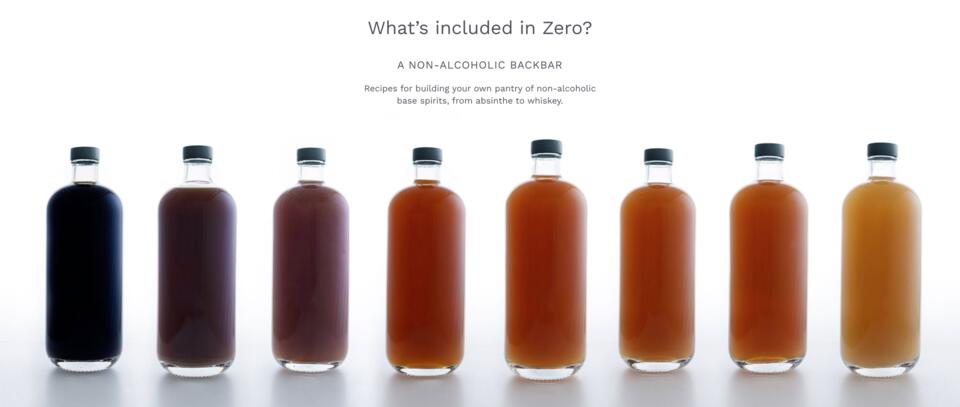
I was enticed by the possibility of creating standard cocktails using non-alcoholic ingredients. It’s probably just a sign that I’m getting older, but I find that, for whatever reason, more and more of my friends aren’t drinking or are drinking less. I want to offer them something just as delicious as what I can make with alcohol, and most mocktail recipes just don’t cut it; they’re frequently little more than fruit juice and soda water.
When I got the book, I couldn’t wait to dig into it. I flipped through the original recipes and gave up on marking the ones I was excited about because it was almost every one. The recipes look unique and delicious (and occasionally complicated)—everything I’ve come to expect from the Aviary. But when I read through the introduction, I was kind of bummed:
[M]ost of these recipes [are] vulnerable to spontaneous fermentation. […] For this reason, avoid storing any of these beverages at room temperature for long periods of time. They can generally stay stable for up to a week in the refrigerator.
Oof. Most ingredients on our bar can last for well over a year without perceptible loss of quality. It definitely wouldn’t be feasible to re-make a complete back bar every week when the last batch expired.
I gave up on building my own NA back bar for months, but I think I’ve finally cracked it, and as far as I know, nobody else is doing this yet.
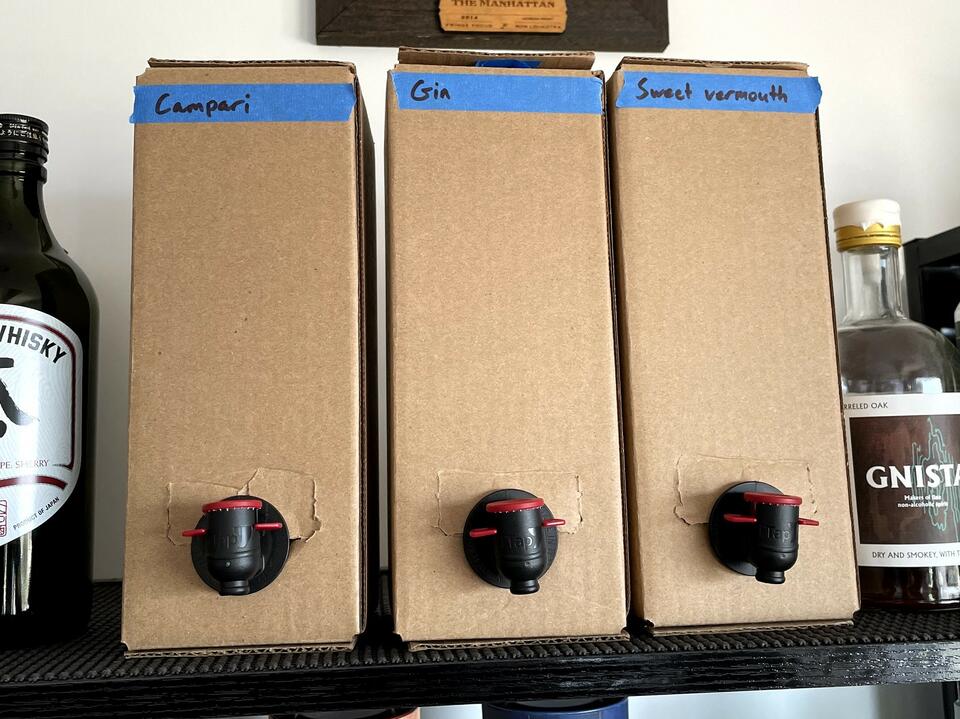
I had several ideas, but none of them seemed like a complete solution. The book recommends freezing as a longer-term preservation mechanism, but that didn’t seem very user-friendly for individual drinks. How long would you have to wait for them to thaw before you could make a drink? Plus what if you only needed half an ounce? Or a quarter?
My first breakthrough came when I, like everyone else during the pandemic, was baking bread. I’d often leave it in my toaster oven to rise. I’d set the warm setting to about 110°F since the internet suggested that above 120°F, the yeast would start to die off. But wait—what if I want the yeast to die off? Could I pasteurize the back bar recipes to kill off yeast? Pasteurization can occur at very accessible temperatures—around 145°F. No yeast, no fermentation.
(I was mildly worried that temperatures that high could cause some of the flavors in the recipes to break down, but most of them cook at upwards of 200°F anyway, so no real risk there.)
I could easily put the prepared NA recipes into vacuum bags and cook them sous vide to pasteurize them, but that didn’t solve the user-friendliness problem. What I really wanted was a sous vide vacuum bag with some sort of tap I could put on it after pasteurizing. My second breakthrough? Realizing that exact product already existed:
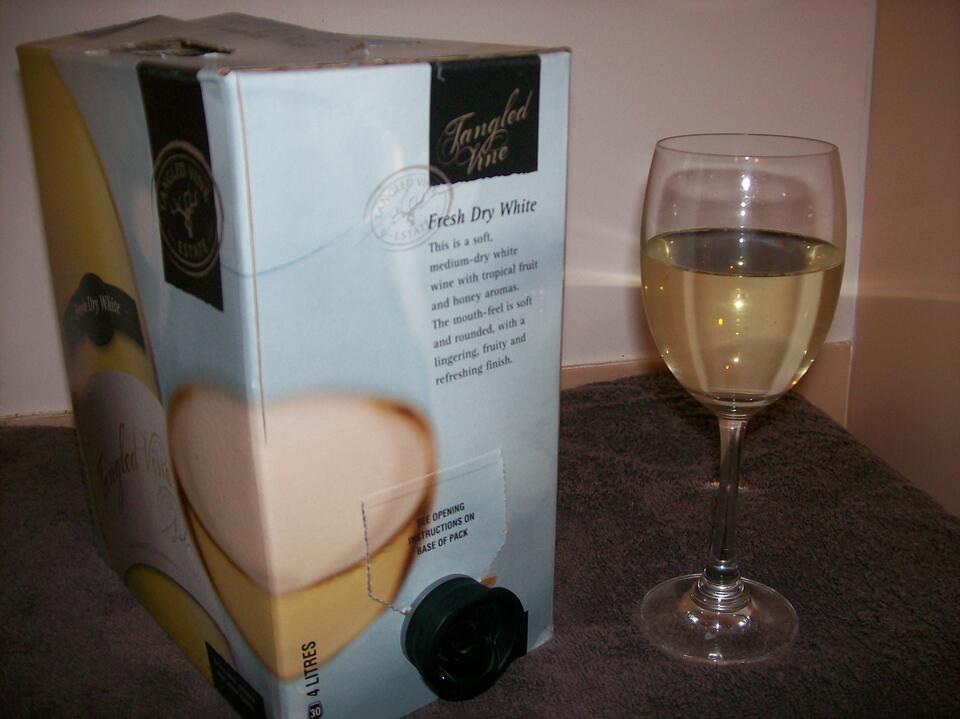
A boxed white wine with a dispenser tap at the bottom
When you dispense wine from a box, air doesn’t replace the space inside of the bag, meaning that the interior remains largely isolated, even as you slowly take the contents out. For boxed wine, this is important because it avoids oxidation (also a secondary concern for me), but if it didn’t allow oxygen, it wouldn’t allow yeast either. So I needed a bag that I could fill myself and was safe to pasteurization temperatures. The latter proved somewhat hard to find—I suspect that most home bag-in-box kits are actually safe to 140°F+, but few of them are documented as such. I ultimately settled on this kit from Astropouch:
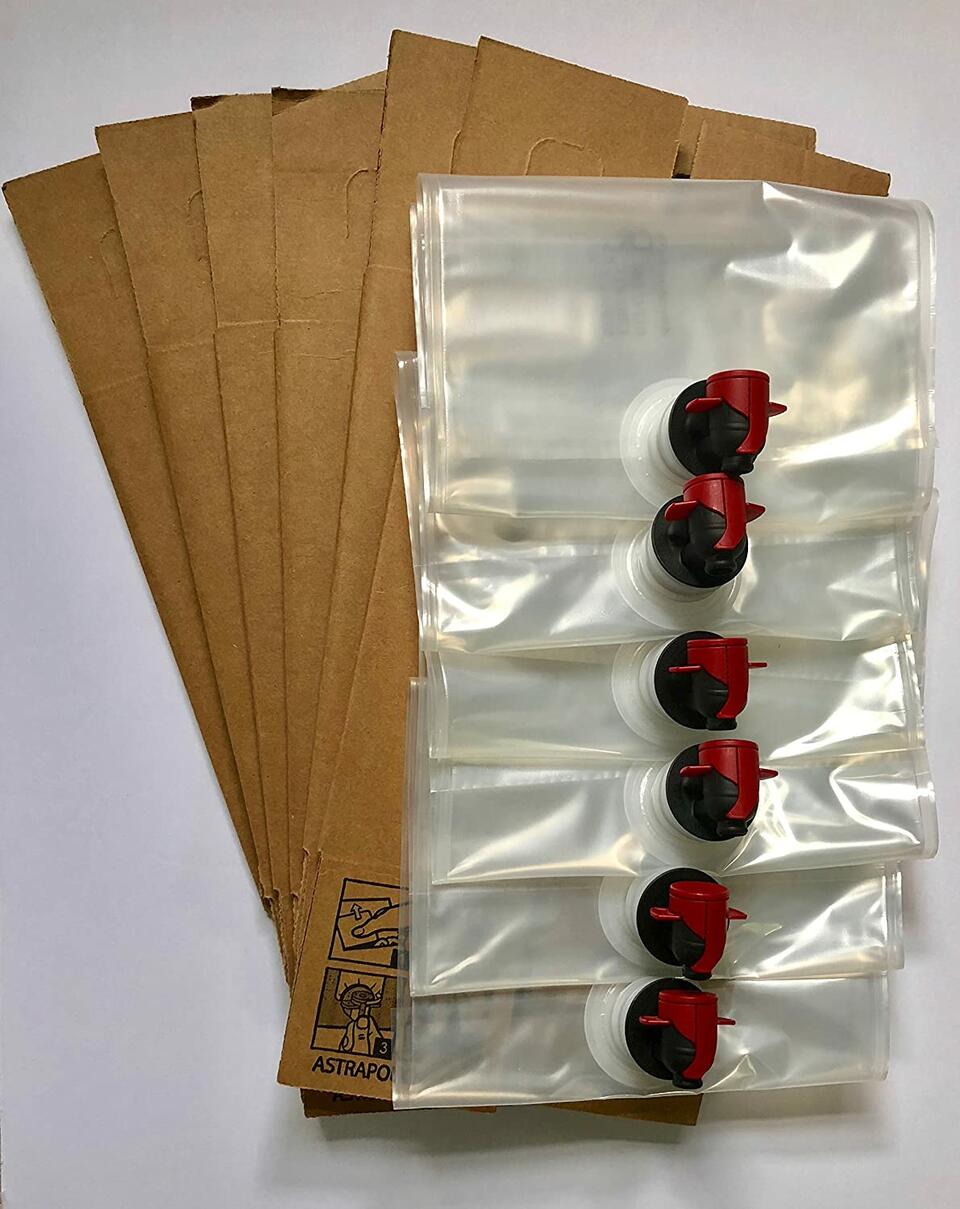
Now that I had a potential solution in hand, I set out to validate my assumptions. I could think of two main things that might go wrong:
- Maybe the taste would degrade significantly. Zero suggests that some recipes will start losing their volatile flavors within a day or two. Perhaps the NA back bar, like vermouths and other wine-based aperitifs, needs to be refrigerated to preserve flavor.
- Maybe it would still ferment. The one-way valves on the bag-in-box kits probably aren’t perfect, so perhaps some air and natural yeast would still get in.
Plus, I wanted to see if the recipes were actually good. I wanted to test them both on their own and in a cocktail, so I picked out the three ingredients of a Negroni and made each of them: the “gin,” the “bitter liqueur” (i.e., Campari), and the “sweet vermouth.”
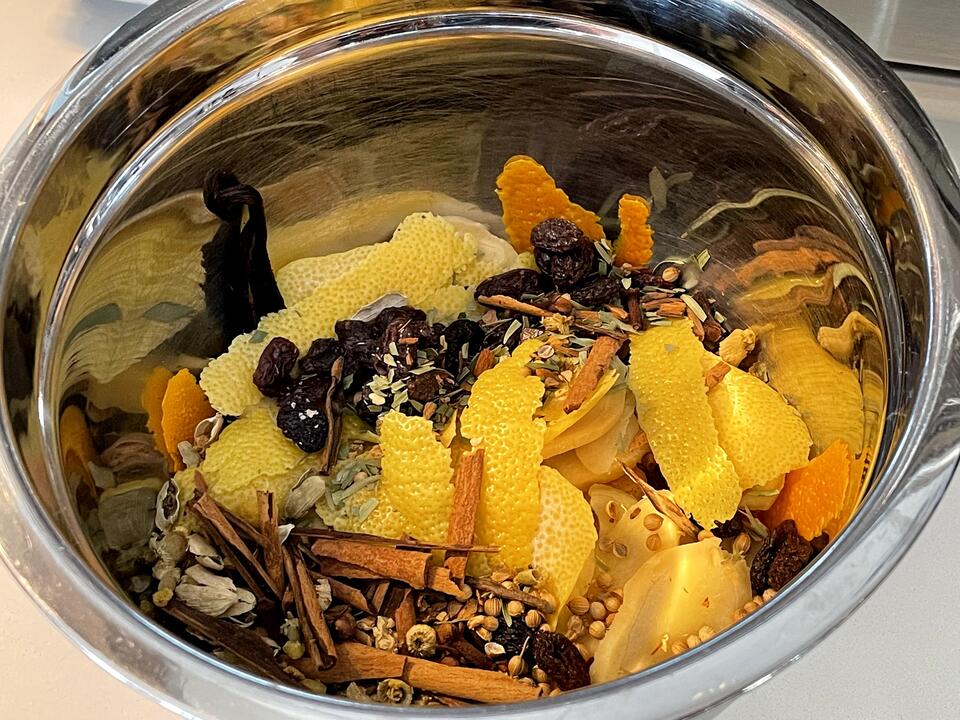
With the addition of some sugar, some water, and some verjus rouge, this bowl of ingredients would turn into the NA “sweet vermouth”
To test if the flavor degraded over time, I froze a couple fluid ounces of each immediately after making it. I could use that as a point of comparison with the rest of the batch, which I stored at room temperature. To test for fermentation, I also measured and recorded the specific gravity of each using a refractometer. This is a common technique in beer brewing. Water with sugar dissolved in it is denser than plain water, and alcohol is less dense than water. If something (yeast) turns the sugar in solution into alcohol, the specific gravity will go down. That’s good for beer but would be bad for me. I want the specific gravity to stay the same.
Finally, I transferred the remainder of each batch into one of my bag-in-box kits, removed the air, and sealed it. I put them all in a cold water bath with a sous vide water circulator, set it to 145°F, and waited until the water had been up to temperature for 30 minutes. (By starting with cold water, I knew that the contents of the bag had been at temperature for the same amount of time as the water)
And then I waited for the bagged samples to “age.”
I figured that if air was going to contaminate the bag, it would be through the taps, so I made a point of dispensing small amounts occasionally. (Letting people compare them against the alcoholic versions also made for a fun party trick). Since Zero recommends storing refrigerated for no more than a week, I let them sit for a month at room temperature. After that, it was the moment of truth: did this work as a preservation mechanism?
For each recipe, I took a sample that I had frozen and a sample that I had aged:
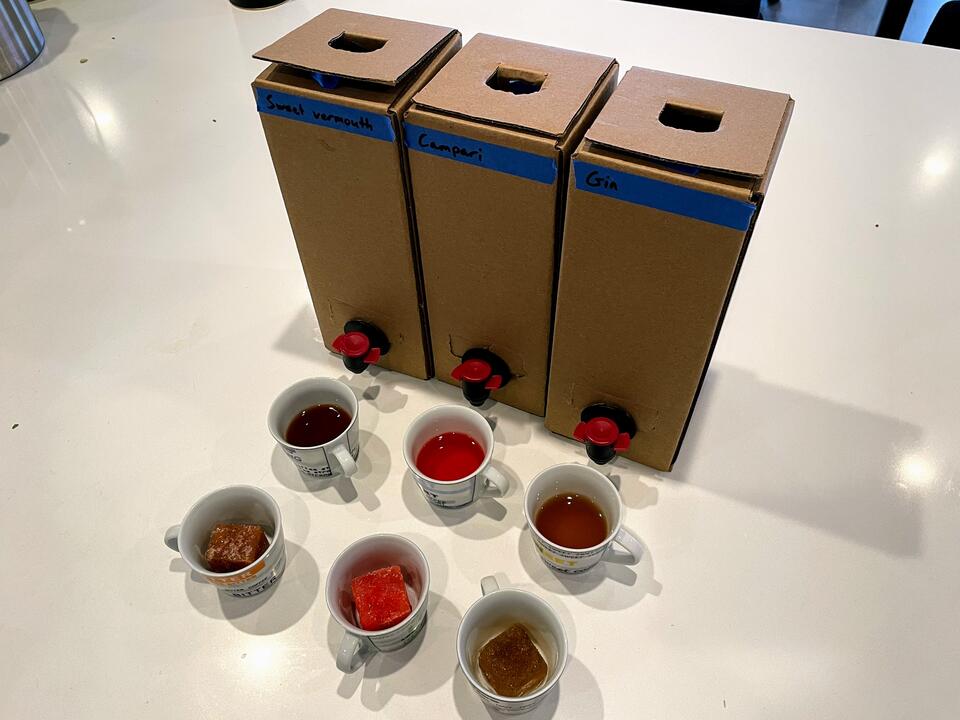
From left to right, “sweet vermouth,” “bitter liqueur,” and “gin”. Frozen samples in the front, aged samples in the back.
I measured the specific gravity of each aged sample again using the refractometer. The readings came back identical (I actually got a slightly higher value, but I think I can chalk that up to the accuracy of my refractometer). That’s great news! It means there was no fermentation! One problem down!
After letting the frozen samples thaw, my roommates and I each tasted them. At first, I was a little worried. They all tasted good but there was definitely a difference between the aged and frozen versions. But I realized that the frozen samples had not fully come up to room temperature. Apparently these recipes need to be served chilled; at room temperature the sweetness is more accentuated.
So I put all of the samples in the fridge until they were all at the same temperature. This time, I couldn’t pick out any difference between frozen and aged versions of the sweet vermouth and the gin. The frozen bitter liqueur had a bit more bitter citrus flavors than the aged sample, which had a slightly more pure sugar sweetness.
My verdict? There are definitely some slight differences between newly made and “aged” versions of the NA back bar, especially for the “Campari.” However, if people compare the aged versions against anything, they’ll compare against the original spirit. I don’t think that the time in the bags changed any of the recipes enough to change their relationship to the aged spirits.
That makes us two-for-two: they don’t ferment, and they don’t degrade. Success!
Of course, you’re probably wondering: how does a non-alcoholic “spirit” taste? Well, Zero suggests that you wouldn’t mistake any of these NA recipes for the original, and I definitely agree with that. But in spite of that, I think they succeed at their stated goal: fulfilling the same function in a drink as the spirits on which they’re based. The “sweet vermouth” smells a little like mulled wine when it’s warm, but cooled down has a very similar balance of botanicals with underlying tannic structure from the “wine” (verjus). The “Campari” not only mirrors the balance of sweet citrus and bitter herbals of the real deal, but it rolls over the tongue in the same way, with all of the sweetness at the front and all of the bitterness in the finish.
Of the three, the “gin” was the only one I didn’t like. I found it sweet and a bit syrupy and lacking enough juniper to really say gin. The recipe calls for vegetable glycerin, which contributes both body and sweetness, and I’m suspicious that there’s too much of that and not enough juniper. More experimentation is required, but of all spirits, gin has the most competitive market in NA alternatives, so I may just lean on commercial solutions instead of making my own.
In spite of that, I’m still stoked that this worked out. I can’t wait to significantly expand my NA back bar over the next few months, although I feel like I need a classier labeling strategy first. I’ve heard good things about the whiskey and the rum, but there are so many recipes to cook up. Maybe the next time I have a friend who isn’t drinking, they don’t need to even pick a dedicated mocktail, but can just have something off of our usual menu.
Want to try this for yourself? Here’s the kit I settled on:
- Astrapouch wine bag-in-box kits (6x 1.5L, although it comes in larger sizes if you’re making in bulk)
And don’t forget that, when pasteurizing, the entire contents of the bag need to be at 145°F for 30 minutes, not just the water that it’s in or the surface of the bag. Starting with cold water is the easiest and safest way to make sure everything heats through at the same time.